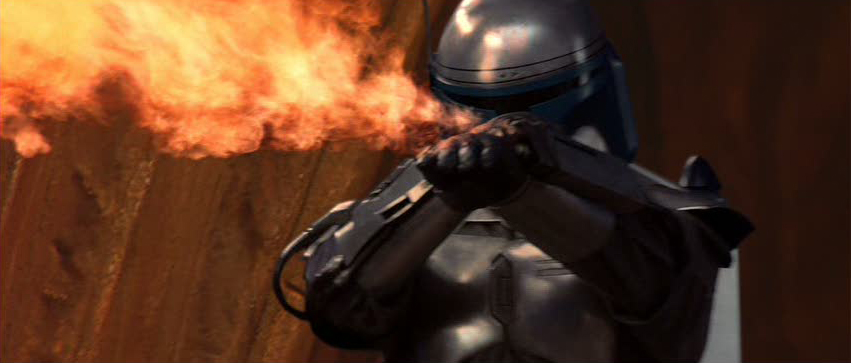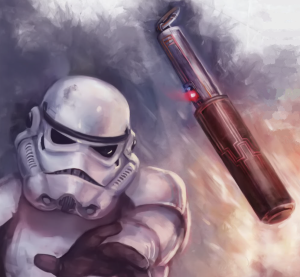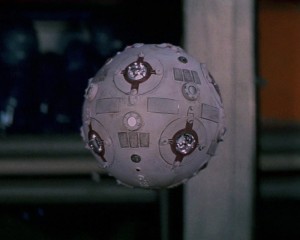
To quote the eternal wisdom of Han Solo: “Hokey religions and ancient weapons are no match for a good blaster at your side, kid.” Of course, as anyone who has seen the rest of the Original Trilogy can attest, he was ultimately proven quite wrong on that point (among a number of others), but perhaps there is a core of truth to his words that we should not completely reject out of hand.
The lightsaber is a formidable weapon in the hands of one strongly attuned to the Force (and a deadly menace to anyone who isn’t that attempts to wield it), of that there can be no doubt, but it must also be noted that it is ultimately just a sword. A laser sword that can cut through steel and bounce blaster bolts like a baseball bat does balls, yes, but still one that shares many of the limitations that caused its medieval counterpart to fall out of use so many years ago in our own history.
In fact, it’s truly remarkable how long the lightsaber has served the Jedi as their weapon of choice: several thousand years without any significant alterations to the design or crippling countermeasures being developed. Let’s put aside the questionable logic of preferring swords in a universe full of guns for a moment, and just look at the frequency with which they hurl themselves into harm’s way and stand in opposition to well-funded and heavily-armed empires, criminal organizations, and other assorted malcontents. One is compelled to wonder why so few seem to give even the slightest thought to attempting to combat the Jedi with anything other than blasters: the one weapon they’ve proven time and time again that they can reliably render completely and utterly ineffective.
It’s not even a question of the universe not yet having invented the technology to circumvent lightsabers, for it clearly already exists and enjoys widespread use. It’s just that apparently nobody has ever connected the dots and decided to employ it where it would do the most good (or bad, as the case may be). Today, we’re going to take a look at that technology and all the ways in which we might exploit it to imperil our favorite heroes and maximize dramatic tension.

The first solution to the Jedi problem, and perhaps the most obvious one, is to overwhelm their defenses with something (or a barrage of many somethings) that can’t simply be knocked out of the air by a single blade. Grenades, for example, would seem to suit our purposes quite well, and are also relatively inexpensive to acquire in great quantities (particularly if one happens to belong to a military outfit). Thermal detonators present another (somewhat more destructive) option for those who are more concerned about their odds of success than the level of collateral damage.
If one wishes for all the benefits of shrapnel but with more control over the direction in which it flies, flechette launchers would appear to be exactly what the situation calls for. A Jedi’s senses are notoriously sharp, which means that mines and other forms of concealed, delayed, or triggered explosives might not function as well as they normally would against baseline organics, but they do present the additional advantage of not requiring the aspiring Jedi-killer to place themselves directly in the line of fire to lob the explosives directly at the intended victim.
This approach was, in fact, put into practice several times during the Prequel Trilogy, most notably by the bounty hunter Jango Fett in Attack of the Clones: his flamethrower gauntlet proving that the Jedi really ought to have invested in fireproofing their robes some time ago. Though it may not have allowed him to triumph over the likes of Obi-Wan Kenobi and Mace Windu, it did seem as though it might just be enough to overwhelm lesser Jedi (which is to say, virtually the rest of the order): odds that could only be improved by using a flamethrower with a greater fuel capacity, a longer range, and a broader spread.

In a rare moment of villainous brilliance, the Trade Federation attempted a similar tactic early on in The Phantom Menace in hopes of disposing of a pair of meddlesome Jedi negotiators, flooding their room with poison gas. Of course, it turned out that Jedi are able to hold their breath for far longer than ordinary humans, but the principle of the thing is still worthy of admiration. Had they thought to use a gas that was corrosive instead of merely fatal if inhaled, the movie might very well have ended right there.
However, speaking of the acuity of their senses raises the point that a great many of their powers seem to rely heavily on their ability to maintain their concentration, which would suggest a glaring vulnerability to weapons designed to disorient and confuse. Interrupting the wizard’s spellcasting, if you will. Stun (or “flashbang”) grenades, which are frequently utilized to great effect by armed forces and law enforcement agencies throughout our own world, offer an excellent means of exploiting this weakness, as does sonic weaponry in general, seeing as how very few Jedi have ever been observed to go into battle equipped with earplugs. On the more physical side of things, simple glop or CryoBan grenades might prove a useful counter to the legendary speed and agility that are so frequently enjoyed by those able to enhance their physical prowess through the Force.

In A New Hope, Luke Skywalker demonstrated to us the existence of small, gravity-defying, laser-firing training remotes, which peppered him with (powered down) blaster bolts in hopes of awakening even a slight trace of his then-dormant connection to the Force. Now, consider what the consequences might have been had the strength of those lasers not been reduced to non-lethal levels. It is one thing to face incoming fire from a squad of stormtroopers, and another entirely to deflect attacks from highly mobile drones capable of assailing a target from multiple and ever-changing angles.
For getting in close when range may not be an option, one might even think to equip them with or otherwise attach vibroweapons (think of a remote control toy helicopter, only self-guided and infinitely more dangerous), which would give pause to anyone thinking of attempting to knock them out of the air. Even if they themselves were not sufficient to bring down a Jedi, they might at least offer vital moments of distraction to be exploited.
If you prefer a method that requires minimal to no effort on your part and carries high odds of success, artificial gravity is a widespread and entirely mundane technology in the galaxy far, far away that has seen remarkably few attempts to weaponize it despite its obvious prevalence. Aboard a starship traveling under normal conditions, it is an indispensable asset. Against boarders, it’s potentially an incredibly effective weapon. Imagine robbing a Jedi of their fabled fleetness of foot by suddenly stripping away the very forces that keep their feet firmly on the ground, or by increasing the strength of the gravity field until the enemy is forced to their knees.
The direction in which they fall might be turned on its head, so that up becomes down, or left and right unexpectedly swap places. Repeatedly. If such technology could be harnessed in more terrestrial environments, at least within a designated area, it could prove a near-inescapable trap that few would ever see coming. If not, repulsor weaponry offers a viable alternative based on similar principles, at least when it comes to eroding the monopoly the Jedi enjoy on being able to fling people and droids around like pinballs just by waving their hands.

For all the colorful lasers and swords that it employs and the futuristic technology that is available, combat in Star Wars remains a startlingly primitive affair, where bringing a sword and a few magic powers to a gunfight universally does give you the best odds of success. Although the weapons and technology profiled in this article have been viewed primarily through the lens of how they might best be employed against the (in)famously formidable members of the Jedi Order, that is hardly the only meaningful use to which we might put them.
Any conflict, great or small, might be rendered more challenging and complex, or even simply interesting, by their addition, and the most ordinary humans given a fighting chance against legendary heroes. Given that we’re talking about a universe where someone once managed to convince Force-wielders that the best way for them to fight was to pick up a laser sword and hit incoming blaster bolts with it to bounce them away, a certain flexibility of the mind when it comes to weaponizing available technology hardly seems like it would be something out of the ordinary. As I see it, our narrative options can only improve and multiply by embracing a greater diversity in our methods of doing harm to other sentient beings.
